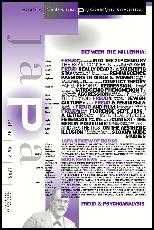
CONTENTS
|
Editing for Psychoanalysis Eve Golden, M.D. |
My
Work: References and Examples
"Eve Golden is a national treasure."
— Arnold D. Richards, M.D.,
editor-in-chief,
Journal of the American Psychoanalytic Association, 1994-2003
I. JAPA AND ME:
I was manuscript editor for the special millennium issue of the Journal of the American Psychoanalytic Association (47/4), pictured at left, and the landmark double issue on psychoanalysis and the life cycle (48/4) that appeared for fall 2000. JAPA 49/3, on teaching and technique, 50/3, on practice and technique, and 51/4, on perspectives on women, were my babies too.II. OUT OF THE WOODS: TALES OF RESILIENT TEENS:
By Stuart T. Hauser, Joseph P. Allen, and Eve Golden. Forthcoming from Harvard University Press in May 2006. Update: It's here!
III. "NARRATION IN THE STUDY OF RESILIENCE," by Stuart T. Hauser, Eve Golden, and Joseph P. Allen, will appear in the forthcoming volume 61 of Psychoanalytic Study of the Child. Update: "Narrative in the Study of Resilience" has been chosen by the Editors as the winner of this year's Albert J. Solnit Award, given for the best paper in the current volume of the Psychoanalytic Study of the Child. The Solnit Award recognizes work that "advances the psychoanalytic understanding of children from clinical, developmental, theoretical, and applied research perspectives." We are thrilled!
IV. "CLOTHES, INSIDE OUT"
The excerpt below is from a paper of mine on the intrapsychic place of clothing, which appeared in I Shop, Therefore I Am: Compulsive Shopping and the Search for Self, edited by April L. Benson, Ph. D., and published by Aronson in the spring of 2000.
After the need to fit in, which we take so much for granted that we usually don't have to be aware of it, most of us care most about how we are seen. Manipulations of distance tend to be unconscious, but we think consciously about pride and shame, hiding and showing, truth and disguise. (Of course, we also don't think about them. Both show in our dress.) This dialectic, including as it does the great sexual tension between the wish to expose and the wish to hide, is the subject that until recently has most exercised psychoanalysts and historians….The main thing about exposure and concealment in clothes is that it's hard to tell them apart. The fig leaf is a fitting symbol because, as has often been pointed out, it draws attention to the sexual organs by the very act of covering them. Clothing always hides, and it always reveals—frequently the same things, and always at the same time…
Clothes by nature possess extremely powerful, near-universal selfobject potential. Although we keep the idea of clothing very close to the idea of self, clothes themselves are immune to the psychic fragmentation that selves undergo; as concrete matter they possess a permanent cohesiveness that the self in need can draw upon. This is the vision behind the expression "coming apart at the seams." The poet John Greenleaf Whittier in a beloved hymn prayed God to "reclothe us in our rightful minds," an exquisite illustration of the metaphor of clothing-as-cohesive-self.
V. REFERENCES FOR PRIVATE WORK: I like best the kind of developmental work with individual authors that helps them fulfill their hopes for their own writing and become ever more skilled and confident. References are available for work ranging in scope from brief addresses to major papers to book manuscripts. Please feel free to e-mail or phone if you would like to speak with analyst/clients who have worked with me.
